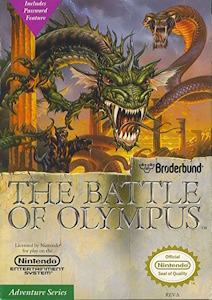
The Battle of Olympus (1988-)
Developer: Infinity Co
Publisher: Imagineer | Brøderbund Software | Nintendo
Genre: Action | Role Playing
Designer: Yukio Horimoto
Composer: Kazuo Sawa
The Battle of Olympus for the NES was developed by Infinity and published by Brøderbund in 1988. The game was initially released exclusively for the NES, and over time it gained a cult following due to its engaging blend of action and mythology-based storytelling. The Battle of Olympus is a side-scrolling action-adventure that draws heavily on Greek mythology, placing players in the role of a young hero named Orpheus who must rescue his kidnapped beloved by battling through mythological creatures and divine challenges across ancient Greece.
The game's inspiration is deeply rooted in classical mythology, particularly the heroic quests and gods of ancient Greece. It is often compared to titles like The Legend of Zelda due to its exploration elements, item collection, and combat mechanics. Players navigate various landscapes, from forests and temples to labyrinths, fighting enemies with a range of weapons and magical powers gained throughout the journey. The gameplay features a mix of platforming and combat, with puzzle-solving elements that require players to use items like the bow, spear, or magic spells strategically to progress.
The Battle of Olympus features a soundtrack that complements its epic theme, with music that evokes the ancient setting while maintaining the tension of an adventurous quest. The sound design plays a key role in immersing players in the mythological world, although the limitations of the NES hardware meant the audio was simple yet effective. The game does not have a prequel, but it stands as an early example of narrative-driven adventure games on the NES, combining exploration and combat in a mythological context.
Upon release, The Battle of Olympus was praised for its challenging gameplay, atmospheric setting, and detailed graphics. While not as commercially successful as some of its contemporaries, it developed a loyal fan base and is remembered as a hidden gem of the NES library. There were no direct sequels, but the game’s blend of action and mythology influenced later titles in the genre. Promotion focused on its unique storyline and connection to Greek myths, appealing to players interested in fantasy adventures beyond the typical sci-fi or fantasy fare common at the time.
Images from MobyGames
Buy The Battle of Olympus
Click one of the Ebay or Amazon buttons below to check the latest prices and purchase The Battle of Olympus for the Nintendo Entertainment System.

Related Searches
The Battle of Olympus is available to purchase and download from a range of vendors. Always shop around...
Various repositories around the internet have scanned and archived a range of retro manuals. Search now to.....
We don't host or link to rom sites for this game. However, there are many sites out there that may be...
Many sites - particularly YouTube - host a range of walkthrough videos to guide you in your quest to get...
There are various sites out there that can offer cheat codes for games. Search now to find all available...
This information can often be obtained through the user manual. Alternatively there are many sites out there...
The initial release date for The Battle of Olympus is stated as 28th March 1988. Other ports of the game may....
There are many sites out there that have collated and documented historic reviews of this game. Search now...
As a Nintendo Entertainment System release, this game was also likely also available on the Famicom. This....
There is now a community of competitive speedrunners who will try and gain the fastest possible time on their....








